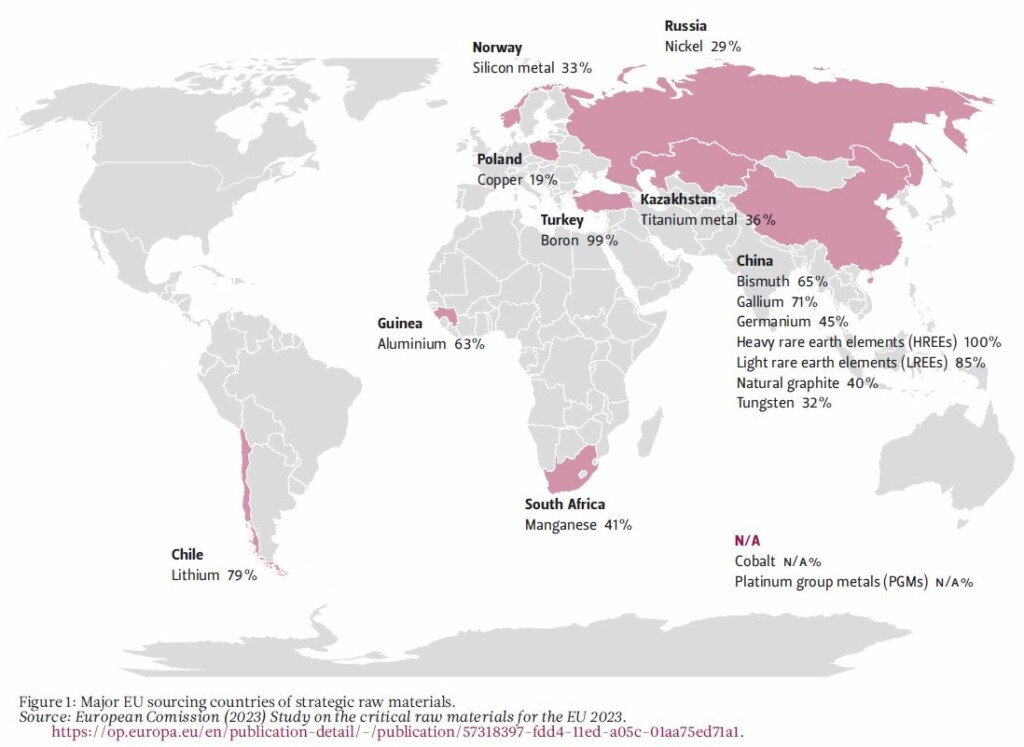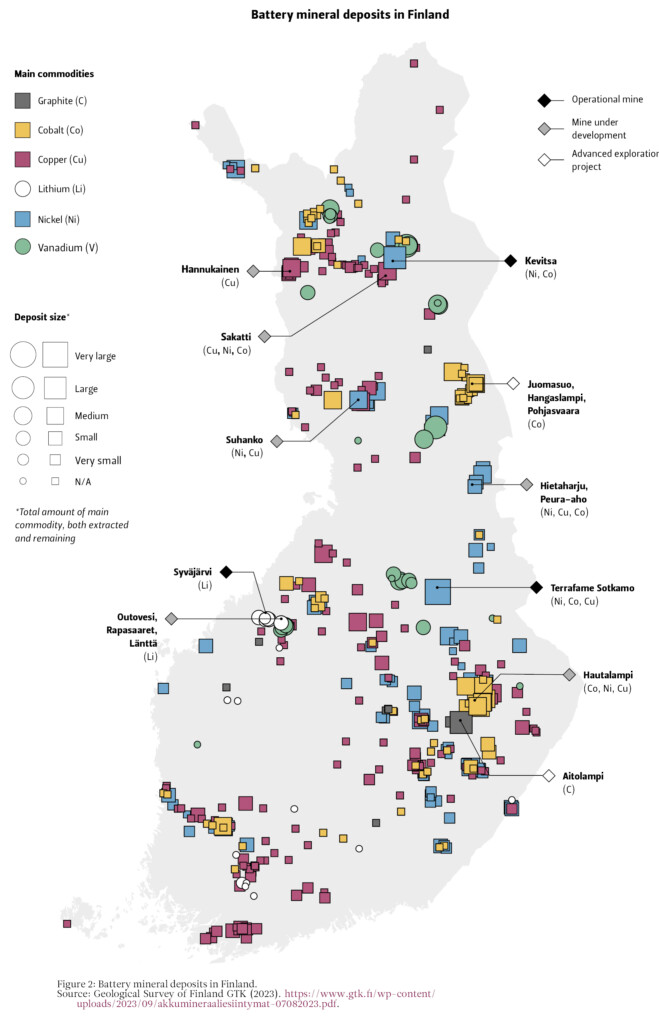yhteenveto
Euroopan unioni on hyvin riippuvainen kriittisten ja strategisten raaka-aineiden tuonnista sekä louhinta- että käsittelyvaiheissa. Monet kyseisten raaka-aineiden keskeisistä toimitusketjuista ovat Kiinan hallinnassa. EU on riippuvainen Kiinasta myös monissa vihreissä teknologioissa, kuten akkutuotannossa.
EU:n kriittisiä raaka-aineita koskeva säädös (2023) asettaa selkeitä tavoitteita vihreään siirtymään liittyvien riippuvuussuhteiden vähentämiseksi vuoteen 2030 mennessä. Tavoitteiden toteutettavuus on kuitenkin kyseenalaista, kun huomioidaan nykyisten riippuvuuksien taso kriittisissä ja strategisissa raaka-aineissa sekä se, ettei säädös sisällä uusia rahoitusinstrumentteja.
Suomalainen kaivossektori on kiinnostava esimerkki, joka havainnollistaa kotimaisen rahoituksen vähäisyyttä. Valtaosa Suomessa sijaitsevista metallimalmikaivoksista on ulkomaisessa omistuksessa, ja sama pätee myös raaka-aineiden jalostukseen ja kierrätykseen.
Jos EU haluaa lieventää riippuvuusriskiä autoritaarisista maista, ulkomaisia sijoituksia tulisi seurata vihreän siirtymän kannalta keskeisillä sektoreilla. Esimerkiksi Suomen laki ulkomaalaisten yritysostojen seurannasta ei kata greenfield-investointeja eli ulkomaisia suoria investointeja uusiin kohteisiin, kuten akkutehtaiden rakentamiseen.
Introduction
In the European Union, the difficult experience of cutting off energy imports from Russia after its attack on Ukraine has highlighted the need to avoid strategic dependencies on authoritarian countries. The logic of reducing geopolitics-related economic risks, or ‘de-risking’, has also been increasingly applied to China, the EU’s largest import partner. ‘De-risking’ is considered particularly important in policies that are central to the EU’s agenda, most notably the low-carbon transition.
Increasing great power competition and protectionism complicate the EU’s operative leeway as it tries to reduce excessive dependencies in the green transition and build more domestic capacity. The US and China entered a new phase of great power competition in October 2022 when the US administered large-scale export controls on advanced AI chips and related software to China. In July 2023, China retaliated by issuing export restrictions on gallium and germanium – two critical minerals needed in semiconductor production and thus crucial for the low-carbon transition. These were followed in October 2023 by restrictions on the export of graphite, which is used as the anode material in lithium-ion batteries. In fact, China halted exports of artificial graphite to Sweden as early as 2020, although it was not until 2023 that Sweden filed this issue with the EU’s trade barrier service. Furthermore, in late December 2023, China also banned the export of rare earth processing technologies.[1]
Currently, and in the foreseeable future, it would not be possible for the EU to pursue the low-carbon transition without Chinese rare earths or battery technologies. In this context, further export controls from China would likely slow down the energy transition and increase its cost. On the other hand, the Union is incapable of matching the massive Inflation Reduction Act (IRA) that the US launched in 2022, which has lured certain European companies in the low-carbon sector to move their planned investments from Europe to the US due to bigger subsidies.
This Briefing Paper examines the EU’s policy objectives to diversify and increase domestic production of green energy against the background of concentrated critical mineral supply chains and Chinese leadership in key green technologies. To provide a concrete testing ground for the EU’s policy plans, the paper looks at actions related to energy transition metals and battery production in Finland – a country that has been relatively welcoming towards the mining industry and overseas investments and is developing a battery supply chain.
We argue that the feasibility of reaching the targets set in the European Critical Raw Materials Act is questionable, considering both the level of existing dependencies in key raw materials and the fact that the Act does not provide new funding instruments. Moreover, reducing single-country dependencies in supply chains of critical materials does not significantly improve the overall level of self-reliance if most of the funding for domestic mining and refining still comes from outside the Union, as in Finland. Furthermore, discussions on increased self-reliance in the green transition should include investment screening reforms, as some member states currently include greenfield investments in their investment screening schemes, while others do not. Although foreign-owned production in the EU brings production closer, it is not always unproblematic, which is why further screening might be needed.
The EU’s green transition and de-risking strategy
The European Commission has proposed to increase the EU’s self-sufficiency in critical minerals by mining and refining a larger share of them in Europe. Critical raw materials (CRMs) are materials that are of both high economic importance and at high risk of supply disruptions, and the Commission has compiled a list of them every three years since 2011. In 2023, a list of 17 strategic raw materials (SRMs) was further specified within the broader list of CRMs. SRMs are defined as being crucial to technologies important for Europe’s green and digital ambitions, and for defence and space applications, while being subject to potential supply risks in the future. For example, gallium and germanium, currently under export restrictions from China, are among the 17 SRMs.
In December 2023, the Commission adopted the Critical Raw Materials Act, which sets concrete targets for reducing dependencies in the green transition by 2030. The targets require that at least 10% of the EU’s demand for SRMs should be covered by production within the Union. Additionally, at least 40% of the processing and at least 15% of the recycling of SMRs should be covered domestically. No more than 65% of the EU’s annual consumption should come from a single third country. The Act also promises to shorten the time needed to acquire extraction permits for strategic projects in the member states to 24 months.[2] Figure 1 shows the EU’s main sourcing countries of SRMs.

Despite its plans to become more self-reliant in the green transition, the EU is highly dependent on China for CRMs and rare earths. Currently, lithium, nickel, cobalt, manganese, and graphite are crucial for battery performance. Rare earth elements are needed to produce permanent magnets for wind turbines and motors for electric vehicles (EVs), and electricity networks need a huge amount of copper and aluminium. The EU provides 1% of the raw materials for wind energy and less than 1% of raw materials for lithium batteries. In broader terms, the Union is “between 75% and 100% reliant on imports for most metals”.[3]
China also plays a significant role in the refinement of many minerals. The European Commission’s 2020 Communication on the resilience of CRMs notes that even when mined in Europe, certain materials such as lithium have to be sent outside the Union for processing. According to the International Energy Agency (IEA), the supply of raw lithium is expected to remain sufficient in the short term, but long-term prospects are grimmer – particularly with regard to lithium chemicals, as their production is highly concentrated. China currently produces around 60% of lithium chemicals as well as 80% of lithium hydroxide. Just five companies dominate the global supply of high-quality, high-purity lithium chemical products.[4] In other words, EU countries also need skills in refining and metallurgy to achieve a resilient value chain of lithium products. Dependence on China’s refining capacity is even higher (100%) in heavy rare earths used for permanent magnets, which is particularly concerning following China’s new export restrictions on rare earth processing technologies.
In addition to relying on China for the acquisition of raw materials and refining, Europe is also dependent on China for technologies that are essential for the green transition. China is a leader in wind and solar energy technologies, the cost of which has decreased by 72% and 90% respectively since 2009, largely thanks to Chinese production in both sectors. At the same time, China’s unrivalled competitiveness poses a severe challenge to European producers, who risk being pushed out of the market. For example, European manufacturers of solar panels have argued that the oversupply of Chinese products has depressed prices in the EU and, if the current situation persists, half of the EU’s production capacity of solar panels may have to shut down. The European Solar Manufacturing Council, an association of EU producers, has thus called on the EU to accelerate the provision of subsidies and the application of measures forcing developers to buy a quota of EU-made panels, or alternatively to impose emergency tariffs on imports. However, tariffs would likely provoke retaliatory measures from China.
Beijing is also the largest global producer of hydrogen; by 2022, 30% of the global electrolyser capacity used to produce renewables-based ‘green’ hydrogen had been installed in China.[5] Hydrogen can be used as an energy carrier, feedstock, fuel, and for storage. It is seen as a solution for decarbonising sectors such as heavy industry and transportation, where reducing emissions is urgent but difficult to achieve. The EU has made green hydrogen the focus of its policy, as its production and use is associated with small emissions. A key challenge is to lower the cost of producing green hydrogen compared to other types of hydrogen and fossil fuels.
China is also the world leader in battery technologies. Due to the volatility of wind and solar energy, power produced from these sources must be stored for later use, thereby creating the need for batteries. In the transportation sector, EVs also utilise batteries. As China’s own EV market is quite saturated and the government ended purchase subsidies for EV customers at the end of 2022, many Chinese EV companies are searching for new markets.
The EU has been conducting an anti-subsidy investigation into Chinese EVs since October 2023, as Chinese state subsidies are allegedly keeping prices artificially low. Consequently, the Union has been trying to stem the import of Chinese EVs. As part of the proposed Net-Zero Industry Act, the EU plans to increase the domestic manufacturing capacity of strategic net-zero technologies, including batteries, to meet at least 40% of the EU’s annual deployment needs by 2030.[6] However, Chinese companies can circumvent these policies by building their battery factories in the EU area. Due to the surge in EV battery factory construction, there was a clear turn in Chinese investments in 2022, with greenfield investments exceeding mergers and acquisitions for the first time since 2008.[7]
Chinese companies, such as the world’s biggest battery manufacturer CATL, want to remain market leaders, which is why they are reacting to material restrictions on lithium and cobalt by developing new chemical mixtures such as sodium-ion batteries. In other words, Chinese companies seem to have a strong grip on the cutting-edge cleantech sector, although batteries free from cobalt, lithium, nickel and graphite are also developed elsewhere.
Considering the level of existing dependencies described above, the feasibility of reaching the targets set in the CRMs Act is questionable. This is particularly the case since it does not provide any new funding instruments. Article 15 of the Act mentions resources from the European Investment Bank Group, the European Bank for Reconstruction and Development and other relevant Union funding and financing programmes in addition to domestic sources, but there appears to be no earmarked funding for mining or refining CRMs in EU countries. Yet meeting the targets of 10% of extraction and 40% of processing and refining by 2030 would require significant investments.
More mining, refining and battery production in Finland?
The Nordic bedrock could supply almost all the CRMs needed within the EU. More specifically, the Nordic countries have been defined as an area in which investments in mining would be particularly helpful in decreasing European dependence on Chinese rare earths.[8] Yet despite the identified potential, there are still significant gaps in the research on Nordic mineral resources, which limits their role in meeting European demand for CRMs.
Within the Union, Finland is the only member state that mines chrome and cobalt, and is overwhelmingly the largest producer of some platinum group metals and nickel.[9] Lithium is the latest addition to CRMs mined in Finland. Keliber mines lithium in central Ostrobothnia and aims to start producing lithium hydroxide in an ore refinery in 2024. Figure 2 presents known battery mineral deposits in Finland.

Finland could also produce rare earths for the EU. In 2022, the Finnish Minerals Group (Suomen Malmijalostus), a special-purpose company wholly owned by the Finnish state, completed a report on the Sokli mine in Savukoski, Lapland. According to the report, Sokli could provide around 10% of the rare earths needed in the EU to produce permanent magnets. The company has not yet completed its study of mineral deposits in the area, and further research is needed before it will be possible to move forward with the necessary permits for production.[10]
Foreign companies own most of the metal ore mines in Finland, as there is not enough domestic capital. Similar trends apply to the refining and recycling of materials. The Confederation of Finnish Industries has collected information on green investments in Finland since 2021, including projects at various stages of development in the battery sector. In five of the 14 listed projects, the investor is completely Finnish. In five of the remaining nine projects, the investors come from Belgium, China, Germany, Norway, and the US. In the remaining four projects, the Finnish Minerals Group has a (minority) share in a joint project with a foreign partner. One of these projects is the above-mentioned Keliber, which is jointly owned by the Finnish Minerals Group with a 20% minority share and South African Sibanye-Stillwater, which owns the remaining 80%.
In 2022, the Finnish Minerals Group and the Chinese CNGR Advanced Materials established a new company, CNGR Finland Oy, to build a factory producing precursor cathode active material for lithium batteries in Hamina. Currently, there is no such facility in the EU area. The Chinese side owns 60% of the joint venture. A related project is located in Kotka, where the Finnish Minerals Group has partnered with Beijing Easpring Material Technology to construct a plant producing cathode active material (CAM). This facility will use the precursor material produced in Hamina in its CAM production. The Finnish Minerals Group owns 30% and Beijing Easpring 70% of the joint venture. In Vaasa, the Finnish Minerals Group is working together with Indian Epsilon Advanced Materials Oy to potentially establish a plant to produce anode material needed to make lithium-ion batteries. This project is in its initial stages, and the available information is limited.[11] It is not possible to compare these 14 investments in terms of value, as only those projects that have passed the feasibility study stage will announce estimates for investment amounts.
In addition to the above-mentioned projects, the authors have come across a joint venture between two Australian companies aiming to produce, among other things, high purity vanadium for use in vanadium redox flow batteries. Their mineral processing facilities are planned to be located in Pori.[12] Chinese company Svolt has also expressed interest in investing in Finland to build a battery cell production facility. In sum, companies from China form the largest foreign investor group in the battery sector. Apart from the Svolt case, the other three projects involving Chinese investors are in the planning stage, meaning that the estimated investment amounts have been published, but the final investment decision has not yet been made.
Conclusions
The scale of the estimated future demand for energy transition metals is overwhelming, making it likely that in the medium term EU countries will have to find a balance between increased local production of key materials, diversification of supply chains, and investments in new emerging technologies. While some degree of strategic autonomy may be needed, it should also be carefully studied how reshoring production will affect the EU’s green transition goals as production in the EU is more costly. The key issue is calibrating the right level of self-sufficiency and effective use of resources to combat climate change.
It would also be useful to have a thorough assessment of future technologies related to the green transition and security of supply of critical raw materials beyond hydrogen. What could the EU and its innovation instruments do to improve sodium-ion batteries so that they could replace lithium-ion batteries? At least in all such cases where there is a minimal margin for supply diversification, more effort should be put into developing replacement technologies for critical raw materials that the Union has to import from any single source.
When it comes to domestic production, mining mineral deposits is only the beginning, as there is demand for refining and further processing, for which EU countries do not necessarily have all the know-how or financial assets. At least in the case of Finland, international cooperation has been necessary – both because there is not enough domestic capital to make investments, and because refining projects often require know-how to scale up production.
Discussions on increased self-reliance in the green transition should encompass investment screening reforms, as some member states currently include greenfield investments in their investment screening schemes, while others do not. Sweden, for example, included greenfield investments in its new investment screening law, which has been in effect since December 2023. The Swedish Inspectorate of Strategic Products screens investments in sensitive sectors according to a specific list issued by the Swedish Civil Contingencies Agency. Screening includes, among others, investments in entities involved in the prospecting, extraction, enrichment or sale of critical raw materials, metals or minerals that are of strategic importance to Sweden. The current Finnish Act on the Screening of Foreign Corporate Acquisitions does not cover greenfield investments, and applying for approval is voluntary in many acquisitions involving Finnish companies that are considered critical for securing vital societal functions.
Endnotes
[1] EU Trade Barriers database. “Export restrictions for artificial graphite products by China”. https://trade.ec.europa.eu/access-to-markets/en/barriers/details?barrier_id=17542&sps=false; see also “Why is China blocking graphite exports to Sweden?” The Economist, 22 June 2023. https://www.economist.com/business/2023/06/22/why-is-china-blocking-graphite-exports-to-sweden; Baskaran, Gracelin, 8 January 2024, “What China’s Ban on Rare Earths Processing Technology Exports Means”. CSIS. https://www.csis.org/analysis/what-chinas-ban-rare-earths-processing-technology-exports-means.
[2] The European Commission 2023. https://single-market-economy.ec.europa.eu/sectors/raw-materials/areas-specific-interest/critical-raw-materials/critical-raw-materials-act_en.
[3] The European Commission 2020. Critical raw materials resilience: Charting a path towards greater security and sustainability, p. 5. https://ec.europa.eu/docsroom/documents/42849.
[4] IEA 2022. The Role of Critical Minerals in Clean Energy Transitions (revised version), pp. 140–142. https://www.iea.org/reports/the-role-of-critical-minerals-in-clean-energy-transitions#overview.
[5] Lewis, Joanna I. (2024) “The Climate Risk of Green Industrial Policy”. Current History 123 (849), p. 16. https://online.ucpress.edu/currenthistory/article/123/849/14/198687/The-Climate-Risk-of-Green-Industrial-Policy; IEA, Global Hydrogen Review 2023, p. 75. https://iea.blob.core.windows.net/assets/ecdfc3bb-d212-4a4c-9ff7-6ce5b1e19cef/GlobalHydrogenReview2023.pdf.
[6] On the Net-Zero Industry Act, see https://single-market-economy.ec.europa.eu/industry/sustainability/net-zero-industry-act_en. Other strategic net-zero technologies include solar photovoltaic and solar thermal, onshore and offshore wind power, heat pumps and geothermal energy technologies, electrolysers and fuel cells, sustainable biogas and biomethane, carbon capture and storage, and grid technologies.
[7] Kratz, Agatha, Max J. Zenglein, Gregor Sebastian & Mark Witzke (2022) EV battery investments cushion drop to decade low: Chinese FDI in Europe 2022 Update. Merics Report. https://merics.org/en/report/ev-battery-investments-cushion-drop-decade-low-chinese-fdi-europe-2022-update.
[8] Eilu, Pasi, Terje Bjerkgård, Hjalti Franzson et al. (2021) The Nordic supply potential of critical metals and minerals for a Green Energy Transition. Nordic Innovation Report. https://www.nordicinnovation.org/2021/nordic-supply-potential-critical-metals-and-minerals-green-energy-transition; European Raw Materials Alliance (2021) Rare Earth Magnets and Motors: A European Call for Action. https://eitrawmaterials.eu/wp-content/uploads/2021/09/ERMA-Action-Plan-2021-A-European-Call-for-Action.pdf; European Commission (2020) Critical Raw Materials for Strategic Technologies and Sectors in the EU – A Foresight Study. https://ec.europa.eu/docsroom/documents/42881.
[9] Vasara, Heino, Jussi Pokki, Bo Långbacka & Mari Kivinen. Kaivosala. TEM toimialaraportit 2023:4. https://julkaisut.valtioneuvosto.fi/bitstream/handle/10024/165277/TEM_2023_4_T.pdf?sequence=1&isAllowed=y.
[10] Finnish Minerals Group (2022) “Soklin kaivoshankkeen alustava selvitys valmistui – vahvistaisi merkittävästi kotimaista mineraalituotantoa” [Preliminary study on the Sokli mine project completed – would significantly strengthen domestic mineral production]. https://www.mineralsgroup.fi/fi/ajankohtaista/uutiset/soklin-kaivoshankkeen-alustava-selvitys-valmistui-vahvistaisi-merkittavasti-kotimaista-mineraalituotantoa.html.
[11] Confederation of Finnish Industries. https://ek.fi/en/green-investments-in-finland/; Finnish Minerals Group. https://www.mineralsgroup.fi/home.html.
[12] EIT RawMaterials (2022) “Win-Win for Europe: Mineral processing facility in Finland set to increase vanadium production for Europe”. https://eitrawmaterials.eu/win-win-for-europe-mineral-processing-facility-in-finland-set-to-increase-vanadium-production-for-europe/.


